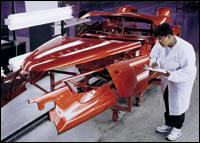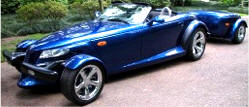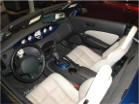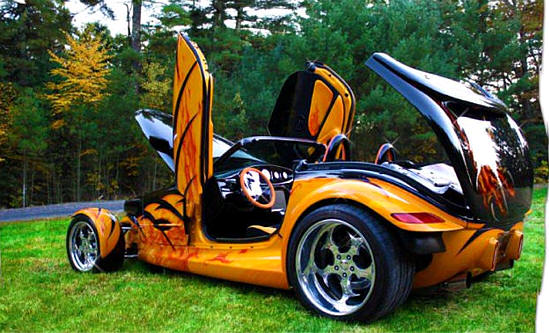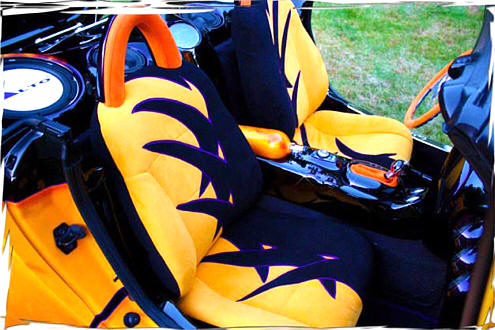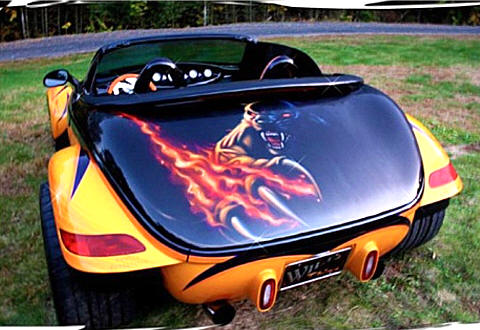|
Facts about the Prowler The Prowler was produced at
the Conner Avenue Assembly Plant in Detroit where they are built alongside
the Beginning in January 2001, it was branded a Chrysler vehicle. The Prowler has the distinction of being North America's most aluminium-intensive vehicle. Last 300 Prowlers were painted Deep Candy Red. The color features a new paint technology in its pearl coat that will actually make the car sparkle in bright light. Originally a five-year run for the Prowler was planned when production started in 1997. Prowler features a 3.5-liter
24-valve sequential multi-point electronic fuel injection, 60-degree Demographics for a Prowler owner: nearly 90 percent male, 70 percent are
married, median age of 52 with a
median income of $190,000. More than 900 pounds of the
2,780-pound roadster is aluminum including body, frame and suspension
parts. The Prowler is made of a high-strength aluminum alloy, as used in airplanes and boats, to resist degradation, noise, and oxidation. A new joining process provides the same body stiffness as steel cars, and careful design allowed for similar safety. Cost is still an issue, since aluminum is four times as expensive as steel per pound, which is why the Prowler is made of aluminum and the mass-produced Neon is not. The magnesium instrument panel, which combines more than 20 stamping and plastic components in a single casting, is eight pounds lighter than a conventional instrument panel construction. An aluminum seat saves another seven pounds. Composite brake rotors take out another 15 pounds of weight. Several aluminum drive line components not only reduce weight but also vibration. The control arms, rocker arms
and knuckles (both front and rear) are made using aluminum that is
pressurized into a die, similar to plastic injection molding. The process
is called semi-solid forming, and it is stronger than traditional casting
with less tendency to weaken over time.
1998 Prowler in a Time Capsule
|
On the Prowl(er) for High Standards The image that comes to mind when you visualize an automotive finishing operation is a scene where a constant flow of cars – arranged end to end – pass through spray booths where finishing robots toil constantly to apply the various colors and clearcoat finishes. Colors are changed frequently, and there is little or no break in the conveyor line of car bodies traveling through the automated system. This image is a surprising contrast to production at MSX International in Detroit, Michigan. You won't find a finishing robot or a conveyor line at this specialty automotive paint facility, because each finishing step is performed by employees who sand, polish, and paint the vehicles manually. Calling on its extensive experience, it maintains the highest standards in show car finishing capabilities. It's this expertise along with its attention to detail that prompted Chrysler to select MSX to paint its high performance, classic-designed roadster — the Chrysler Prowler which was produced from 1997 through 2001. (The last Prowler was sold at auction in May, 2002. See sidebar, page 61.) “The Prowler appeals to a very specific driver,” said Gary Cibula, MSX Plant Operations Manager. “Production numbers were significantly lower than the typical production volume of automobiles, so it didn't make sense for a large automaker to dedicate production space for these custom products. Instead, companies like ours performed special services for them, such as painting body parts.” MSX International offers the automotive industry a complete range of specialty build services from fabrication to assembly, including full-body paint capabilities. They have facilities worldwide.
“Even in our situation, a robotic or automated system was not feasible,” said Mr. Cibula. “Our daily production of Chrysler Prowlers was 14-17 vehicles. It did not make economical sense to install an automatic finishing system with robotic capabilities for such a short daily run.” This lack of automation does not mean that MSX didn't take advantage of new advances in finishing technology. If new equipment or production methods are cost effective, and can increase production and quality, they will look at the product or process closely. For instance, when MSX designed the finishing facility for the Prowler in 1995, it needed a system to accurately mix two-component clear coat. It wanted something that was economical, precise, and easy to operate. After careful evaluation and input from the paint supplier, contractor, Chrysler and local finishing equipment supplier, MSX selected Graco's Precision Mix electronic proportioning system. The Precision Mix proportioner sequentially metered and dispensed the two-component clear coat—a 1:1 ratio, high gloss formula from PPG. The patented digital control unit provides a maximum flow rate of 4,000 cc/mm and assures proportioning accuracy within +1%. Volume ratios vary infinitely from 0.6:1 to 30:1. MSX installed the proportioner outside the clear coat spray booth so operators had easy access to it. According to Richard Underwood, paint job supervisor, the system is simple and reliable. “Our production people don't have to worry about off-ratio problems, because they're getting the same pre-selected recipe whenever they pick up their spray guns. They can verify this input on the proportioner's screen monitor. This allows our painters to focus on what they do best and that's applying a quality finish.” “We haven't had any problems with the system since it was installed,” he added. “It does exactly what we expect it to do—day in and day out.” In fact, the proportioner did such a good job mixing and dispensing clear coat that MSX added a second system to proportion clear coat in another booth. According to Mr. Underwood, “We were hand-mixing the 1:1 ratio material and spraying it from pressure pots. It wasn't a very economical operation. The system has allowed us to reduce labor and material expenses.” Another benefit of the system is its reporting capabilities. The system allows MSX to monitor material usage. It used the information to analyze production and VOC trends. The clear coat components are transferred from a central pump room where they are pumped from 55-gallon drums to the respective proportioner. Graco Glutton 4:1 stainless steel diaphragm pumps were recently installed to transfer the plural component materials. “We replaced a number of other pumps that didn't have the output we required. The Glutton pumps are providing with the pressure and flow we need to meet our system requirements,” said Mr. Underwood. Prowler System Operation he first material MSX sprayed was a single-component primer. Painters using conventional air spray guns applied three coats to attain a coverage of 1.5 mils. The primer is fast-drying, allowing the second and third coat to be applied 3-5 minutes after the previous coat. After the primer was applied, the painter wheeled the cart into a heated area where the primer cured at 95F for 20 minutes. From this heated area, the parts were moved into a two-stage oven. Temperatures were 240F in the first stage and 290F in the second stage. Parts remained in each stage for 20 minutes. According to Mr. Underwood, this provided optimum cure rate and also kept the product moving smoothly through the system. After the parts were removed from the primer oven, they were inspected. Any imperfections caused by dirt or other airborne contaminants were sanded out of the finish. These parts were washed and retouched. Then the cart was wheeled into the color booth where the base coat was applied. “We had a unique situation here” said Mr. Cibula. “Many automotive finishing operations have to contend with frequent color changes during the day. Our color batches were for 800 vehicles, so once we start painting a color we stayed with that color for approximately three months. “To say the least, a color change was a big event here,” he added. “After spraying the same color for three months, our painters really looked forward to a change!” After the color coat was sprayed, the parts were transported to a flash zone to drive the solvents out of the base coat. They remained there for 20 minutes at 110F. From the flash zone, the carts were rolled into the clearcoat booth where painters applied a polyurethane coating of 2.2 to 2.5 mils. After the parts were sprayed, they were rolled into an infrared flash zone for 20 minutes and then into another two-stage oven where the parts were heated at 195F and 285F, respectively. Next, every inch of the parts finished surface was inspected. Upon passing inspection, the high gloss parts were meticulously polished. The parts were transported to a final inspection area. When they passed this inspection, they were transported to another part of the facility and were “signed” back to the company that fabricated the parts for assembly. Typically, a cart carrying the parts of a complete Prowler was in MSX's control for 48 hours. “When the parts left our facility they carried the best finish available today,” Mr. Underwood concluded. “And the Graco Precision Mix proportioners helped us attain that finish. They have met our quality requirements and have proved over the last six years to be very reliable.”
|
|||
|
Last Prowler - Going to Auction for a Worthy Cause
The last and most creative Chrysler Prowler ever built - complete with a time capsule that contains rare Prowler memorabilia, including signed, original styling sketches and other unique Prowler items - was auctioned at Christie's Auction House in Manhattan, N.Y. on May 18, 2002 for $175,000 The DaimlerChrysler Corporation Fund, the company's philanthropic arm, donated the 2002 model year Prowler to the National Multiple Sclerosis Society (NMSS) for purposes of the auction. The NMSS received all proceeds from the auction of the Prowler. The final “Conner Avenue Edition” Prowler was built at the Conner Avenue Assembly Plant in Detroit on Feb. 15, 2002. In addition to being the first and only Prowler with High-Voltage Blue exterior body paint, it featured a bright anodized frame, unique body-color hood badge, custom-wrapped shifter knob, and signatures of the Prowler Team on the undercarriage. Prowler first appeared as a concept car at the 1993 North American International Auto Show in Detroit. Favorable response prompted the former Chrysler Corporation to unveil a production version of Plymouth Prowler at the 1996 North American International Auto Show. Official production began in June, 1997 as a 1997 model at Conner Avenue Assembly Plant. With the discontinuation of the Plymouth brand in January of 2000, Prowler continued as a Chrysler. |
||||
|
|
||||
|
Back to Top
|
||||
TheProwlerStore.com is a Hot Car Accessories, Inc. site

